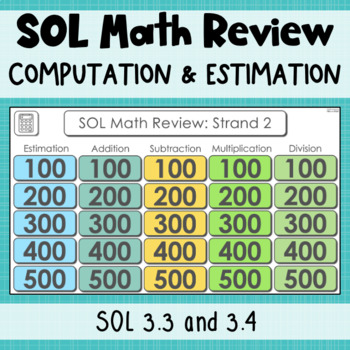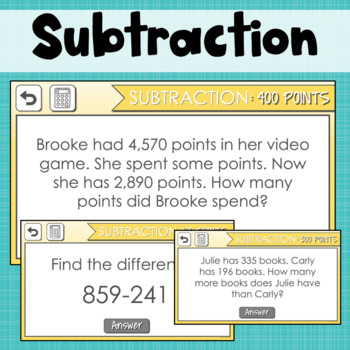3rd Grade Math Review Game - Addition, Subtraction, Multiplication, Division
- Zip
What educators are saying
Also included in
- Time to review for the 3rd grade Virginia Math SOL? Use these digital Jeopardy-style games to review concepts from the whole year! This bundle gives you the opportunity to buy 4, get 1 free!Keep reading to see which standards each game covers and how it works. Students will love working in teams durPrice $16.00Original Price $20.00Save $4.00
Description
Time to review for the 3rd grade Virginia Math SOL? Use this Jeopardy-style game to review concepts in Strand 2: Computation and Estimation. Students will love working in teams during this fun, no-prep activity!
What are the categories?
- Estimation
- Addition
- Subtraction
- Multiplication
- Division
How does it work?
- Students work in teams (up to five teams if you use the digital scoreboard)
- Take turns letting teams pick a category and point value. 100 point questions are the easiest and 500 point questions are the hardest.
- Every team answers the question. To check the answer, click on the "Answer" button and it will transition to a slide with the answer.
- To reward team points, click on the calculator icon and tap to add points.
- Point values and categories will reset when you exit presentation mode. If you are unfinished, jot down team scores and which questions remain!
Is it editable?
No, but you can type in team names.
What standards did you use to create the questions?
SOL 3.3 The student will...
a. estimate and determine the sum or difference of two whole numbers
b. create and solve single-step and multistep practical problems involving sums or differences of two whole numbers, each 9,999 or less.
SOL 3.4 The student will...
a. represent multiplication and division through 10x10, using a variety of approaches and models
b. create and solve single-step practical problems that involve multiplication and division through 10x10
c. demonstrate fluency with multiplication facts of 0, 1, 2, 5, and 10
d. solve single-step practical problems involving multiplication of whole numbers, where one factor is 99 or less and the second factor is 5 or less.
I hope your kids LOVE this activity and you find it helpful as you prepare for the big test!
Check out my blog post: How to Optimize Jeopardy Review Games for tips and strategies!
TERMS OF USE - © VA SOL Superstars
This item is a paid digital download from my TpT store
https://www.teacherspayteachers.com/Store/Va-Sol-Superstars
As such, it is for use in one classroom only. This item is also bound by copyright laws. Redistributing, editing, selling, or posting this item (or any part thereof) on the Internet are all strictly prohibited without first gaining permission from the author. Violations are subject to the penalties of the Digital Millennium Copyright Act. Please contact me if you wish to be granted special permissions!






